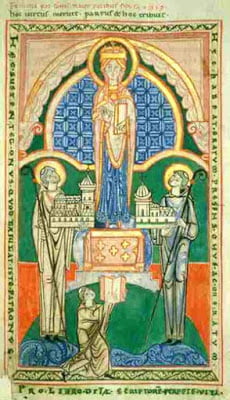How do we honor today, in this 21st century, the founders of our Order, Sts. Robert, Alberic & Stephen? What can we draw out from the sketchy and spare details we have of their beginnings to tell us what their vision was, what the impulse was, what was the force behind their movement to begin a new community, which in a relatively short time developed into a full fledged Order? If I had to choose two words to capture the essence of what propelled these courageous and dedicated monks they would be these: ‘mystical’ and ‘contemplative’. Once a monastery and even an Order becomes established, the greatest risk for both is losing sight of what is vital to its way of life. To renew ourselves we always have to return to the vision, to re-vitalizing what gives monasticism its perduring reality. And these two words bring us face to face before the essence of monastic life.
‘Mystical’ and ‘contemplative’, words that carry so much history and meaning, words also that have been misused and misunderstood. We might wonder how we understand them right now in our monastic lives. ‘Mystical’ is related to ‘mystery’, not an extraordinary reality, rather a reality that one cannot grasp or understand through a mundane or profane consciousness. Mystery is experienced and apprehended in a non-rational way; we perceive the divine reality with a consciousness that is rooted in the intuitive, poetic, imaginative, inspirational dimension of ourselves. The ancients used the expression of ‘seeing with the spiritual senses’. Michael Casey, in an essay titled “Contemplation”, writes: “What monastic life offers is a slow process of purifying the heart so that it can perceive the deep mystery in which we have been immersed” (Strangers To the City, p.158). And, indeed, one of the beatitudes tells us that ‘the pure of heart will see God’. The ‘pure of heart’ will see, a heart open to daily conversion ‘sees’ because each moment of conversion roots us in a more encompassing truth, God’s truth and our own. Michael Casey offers this understanding of ‘mysticism’: “When we speak of mysticism…we are speaking of our capacity to be drawn sometimes into a zone beyond the familiar world of space and time, a zone in which all our interior faculties come alive. What transpires during those graced moments is beyond language. God is a reality that we can never explain or prove” (p.159). It is this other ‘zone’ that informs a consciousness that is sensitive and open to receiving and perceiving the Spirit’s ever-so subtle promptings and whisperings in our hearts. In these moments it is so true that our ‘interior faculties come alive’, they expand and root our consciousness so that we truly begin to take on the mind and heart of Christ.
Our founders sought to cultivate this monastic or mystical consciousness both in the inner life and without, in their physical environment. One may wonder: did they not have this at Mosleme? Or, did life there become too institutional, too rich, too excessive in its liturgical practices, that the simplicity and essentials of what they sought got buried beneath all this wealth and success? God is found as much outside of formal prayer times as within them, in nature, in serving one another, in a loving gesture given to us by another. But how do we perceive these moments throughout the day? We are not to make a split between finding God in the church and not finding God in our daily work. It is this mystical consciousness that holds together the sacred and profane, that enables us to see and experience God in our everyday experiences. Only a mystical consciousness can perceive God’s hand at work in the vulnerability of our sister and in our own vulnerability. We are imperfect wounded beings. Do we then see one another with the eye of criticism or do we see with a more encompassing eye, beholding as well the beauty of each one of our sisters and brothers? ‘I thank you because you have created me so wonderfully’, says the psalmist. Prayer, meditation and the process of conversion are the main practices we have to cultivate a contemplative, mystical way of seeing and being. The monastic adage: ‘to pray unceasingly’ is not so much about ‘saying’ prayers as it is about living with our spiritual senses fully awakened and alive. A mystical, contemplative consciousness has to do with awareness, awareness of entering this other ‘zone’ at different times throughout the day; awareness of when we have fallen into a cut-off consciousness, cut off from our heart center, cut off from our God.
Surely we honor our founders by growing into the consciousness that will enable us to perceive the face of Christ, the reality of God’s life present in these ordinary experiences.


